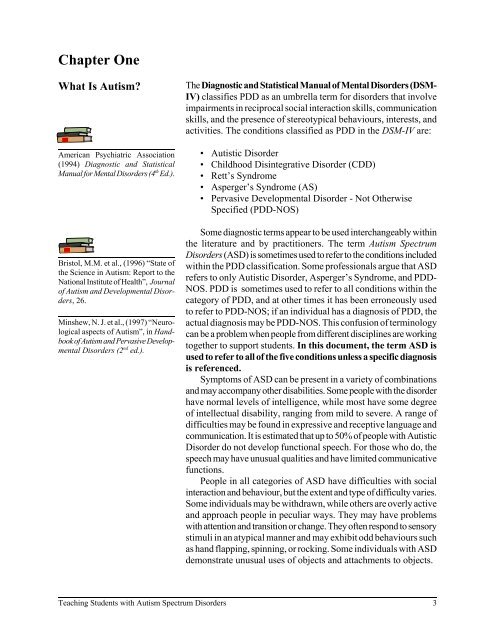Teaching Students with Autism Spectrum Disorders
Teaching Students with Autism Spectrum Disorders
Teaching Students with Autism Spectrum Disorders
You also want an ePaper? Increase the reach of your titles
YUMPU automatically turns print PDFs into web optimized ePapers that Google loves.
Chapter One<br />
What Is <strong>Autism</strong>?<br />
American Psychiatric Association<br />
(1994) Diagnostic and Statistical<br />
Manual for Mental <strong>Disorders</strong> (4 th Ed.).<br />
Bristol, M.M. et al., (1996) “State of<br />
the Science in <strong>Autism</strong>: Report to the<br />
National Institute of Health”, Journal<br />
of <strong>Autism</strong> and Developmental <strong>Disorders</strong>,<br />
26.<br />
Minshew, N. J. et al., (1997) “Neurological<br />
aspects of <strong>Autism</strong>”, in Handbook<br />
of <strong>Autism</strong> and Pervasive Developmental<br />
<strong>Disorders</strong> (2 nd ed.).<br />
The Diagnostic and Statistical Manual of Mental <strong>Disorders</strong> (DSM-<br />
IV) classifies PDD as an umbrella term for disorders that involve<br />
impairments in reciprocal social interaction skills, communication<br />
skills, and the presence of stereotypical behaviours, interests, and<br />
activities. The conditions classified as PDD in the DSM-IV are:<br />
• Autistic Disorder<br />
• Childhood Disintegrative Disorder (CDD)<br />
• Rett’s Syndrome<br />
• Asperger’s Syndrome (AS)<br />
• Pervasive Developmental Disorder - Not Otherwise<br />
Specified (PDD-NOS)<br />
Some diagnostic terms appear to be used interchangeably <strong>with</strong>in<br />
the literature and by practitioners. The term <strong>Autism</strong> <strong>Spectrum</strong><br />
<strong>Disorders</strong> (ASD) is sometimes used to refer to the conditions included<br />
<strong>with</strong>in the PDD classification. Some professionals argue that ASD<br />
refers to only Autistic Disorder, Asperger’s Syndrome, and PDD-<br />
NOS. PDD is sometimes used to refer to all conditions <strong>with</strong>in the<br />
category of PDD, and at other times it has been erroneously used<br />
to refer to PDD-NOS; if an individual has a diagnosis of PDD, the<br />
actual diagnosis may be PDD-NOS. This confusion of terminology<br />
can be a problem when people from different disciplines are working<br />
together to support students. In this document, the term ASD is<br />
used to refer to all of the five conditions unless a specific diagnosis<br />
is referenced.<br />
Symptoms of ASD can be present in a variety of combinations<br />
and may accompany other disabilities. Some people <strong>with</strong> the disorder<br />
have normal levels of intelligence, while most have some degree<br />
of intellectual disability, ranging from mild to severe. A range of<br />
difficulties may be found in expressive and receptive language and<br />
communication. It is estimated that up to 50% of people <strong>with</strong> Autistic<br />
Disorder do not develop functional speech. For those who do, the<br />
speech may have unusual qualities and have limited communicative<br />
functions.<br />
People in all categories of ASD have difficulties <strong>with</strong> social<br />
interaction and behaviour, but the extent and type of difficulty varies.<br />
Some individuals may be <strong>with</strong>drawn, while others are overly active<br />
and approach people in peculiar ways. They may have problems<br />
<strong>with</strong> attention and transition or change. They often respond to sensory<br />
stimuli in an atypical manner and may exhibit odd behaviours such<br />
as hand flapping, spinning, or rocking. Some individuals <strong>with</strong> ASD<br />
demonstrate unusual uses of objects and attachments to objects.<br />
<strong>Teaching</strong> <strong>Students</strong> <strong>with</strong> <strong>Autism</strong> <strong>Spectrum</strong> <strong>Disorders</strong> 3

















